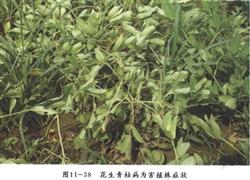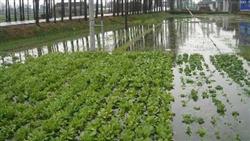Control techniques of Peanut bacterial Wilt and Stem Rot

First, peanut bacterial wilt 1, symptoms. The disease of peanut bacterial wilt began to occur before and after flowering, but the disease was the most serious at the stage of flowering and needling, and the disease was alleviated after podding. The characteristics of the greatest symptoms are as follows: the upper leaves of the diseased plant withered rapidly, the vascular bundles of the underground roots turned brown, the longitudinal rhizomes, and turbid bacterial pus could be exudated from the squeezed incision when it was moist. If the section of the rhizome disease was suspended and immersed in clean water, it can be seen that smoke-like turbid fluid gushed out from the incision, which is a reliable basis for the diagnosis of the disease. Usually the chlorophyll of the withered leaves has not been destroyed, although the leaves are not shiny, they are still green, hence the name bacterial wilt. 2. The regularity of the disease. The pathogenic bacteria of bacterial wilt overwintered mainly in soil, but also in diseased remains and soil fertilizer. Diseased soil and diseased fertilizer were the main sources of primary infection of the disease in the following year. Bacteria spread through soil, Rain Water, irrigation water, agricultural activities and so on, and invaded from the host rhizome wound or natural orifice. The occurrence and prevalence of the disease is closely related to weather, soil, farming system, plant growth period, variety resistance and other factors. High temperature and heavy rain, especially when it is sunny and rainy, or prolonged drought and sudden rain, and sharp changes in soil temperature and humidity are the most likely to induce the disease; the coarse sand with shallow soil layer and poor water and fertility conservation or yellow clay with poor permeability are favorable for the disease; the disease in continuous cropping land is more serious than that in rotation land; it is easy to occur when nitrogen fertilizer is applied in continuous cropping land; trailing type varieties are more resistant than direct type and pearl bean type varieties; southern type varieties are more resistant than northern type varieties. The incidence from pre-flowering to podding stage accounted for more than 70% of the incidence during the whole growth period. 3. Control measures ⑴ reasonable rotation. It is best to implement flood-drought rotation, at least with sugarcane, sweet potato and other dry land rotation. The number of years of crop rotation depends on the severity of the disease. Resistant varieties were selected for ⑵. Xie Kangqing 10, 11, Tianfu 11, Yuhua 14, Yuanza 9102, Yueyou 589,320, Guiyou 28, Quanhua 3121, Taishan Pearl Dou can be selected according to local conditions. ⑶ strengthens cultivation management. Turn the soil deeply in the sun or divert water to soak the field (the longer the time is, the better); regulate the drainage and irrigation system, improve the ability of preventing waterlogging and drought resistance, prevent series irrigation, properly increase lime, adjust soil acidity, remove central diseased plants in time, and pay attention to field hygiene; formula fertilization, avoid partial application of nitrogen fertilizer, do not apply soil fertilizer with diseased residues. ⑷ adopted the method of picking and treating by spraying liquid to block the disease center. 20% quinolinone 1000 times solution, or potassium permanganate solution or copper ammonia solution can be used to spray gonorrhea points and adjacent healthy plants for 2-3 times or more times, which plays a certain role in blocking the disease center and controlling the spread of the disease. 2. Peanut stem rot occurs in all the producing areas of the country, especially in the northern producing areas, which often results in the death of large areas of plants. 1. Symptoms. The disease can occur in both seedling stage and adult stage of peanut. The disease site is at the base of the stem and root neck near the ground of the plant, the affected part is yellow-brown to black-brown wet rot at first, then turns to dry rot, and the surface of the disease is densely covered with small black grains as big as needles, which is the conidium of the pathogen. In severe cases, the basal cortex of the stem fell off and the whole plant withered. 2. The regularity of the disease. The pathogen is mainly left in the soil or mixed with soil fertilizer to overwinter. it can also adhere to the pods and kernels and spread by wind, rain or agricultural operation, and invade directly from the host wound or epidermis. The occurrence and prevalence of the disease is closely related to weather, seeds, cultivation management, variety resistance and other factors. Warm and rainy, heavy soil moisture, or heavy rain sudden sunny, sharp changes in soil temperature; dry climate, high soil surface temperature, plant burns, often easy to induce the disease; harvest time Rain Water, seed pods were not fully dried into the warehouse, or poor storage after storage caused seed pods mildew, seed vitality decreased, seed carrier rate increased, easy to occur after sowing In the continuous cropping land, the disease was more serious in the plots with poor soil structure and fertility, or with the application of soil fertilizer with diseased remains, and the disease of spring peanut was more serious than that of summer peanut, and the disease of early sowing spring peanut was more serious than that of late sowing. 3. Prevention and control measures. Comprehensive control measures should be taken, which should be dominated by agricultural control and supplemented by chemical control. Change resistant varieties in ⑴ serious disease area, do a good job of seed selection, retention and storage, and rotate with Gramineae crops for 1-2 years. Seed dressing and disinfection before ⑵ sowing. You can choose 40% triadimefon carbendazim wettable powder or 45% triadimefon thiram wettable powder for 24 hours before sowing (the amount of seed is 0.3% of the seed weight). ⑶ strengthens cultivation management. Thoroughly clean the fields during harvest, collect disease residues and burn them; do not use diseased vine heap compost, do not apply soil fertilizer with diseased remains; adjust sowing time appropriately according to local conditions; improve the drainage and irrigation system to improve the ability of planting land to prevent waterlogging and drought; formula fertilization, increase the application of phosphorus and potassium fertilizer; fine soil preparation, pay attention to sowing depth and soil cover, promote early seed germination. ⑷ should do a good job of spraying to prevent and control the disease. Spray the insecticide once after the seedling, before flowering and at the stage of full flowering, with emphasis on the base of the stem. In addition to selecting 1000-1500 times of the above-mentioned seed dressing solution, you can also choose 1000-1500 times of 75% chlorothalonil wettable powder (1:1), or 1000 times of copper oxychloride plus 70% mancozeb wettable powder (1:1). Or 65 grams of bacteria wettable powder spray control.
- Prev

Pest Control in Peanut growth
1. The cause of iron deficiency in peanut peanut is one of the crops sensitive to iron. Although iron is not a component of chlorophyll, it is an indispensable condition for the synthesis of chlorophyll. It is a component of cytochrome oxidase and peroxidase related to respiration, and participates in the redox process in plants. Is.
- Next

Prevention and Control techniques of Peanut waterlogging
The occurrence of peanut waterlogging is due to low-lying terrain, heavy soil and poor drainage; second, in the season of long rainfall or excessive rainfall, there is excess surface water and groundwater, which can not be discharged temporarily. According to the characteristics of water requirement for peanut growth and development, the soil relative humidity at peanut seedling stage is 50%-60%.
Related
- The first cup of black tea in spring, the flavor and history of tea gardens in Kenya, Africa
- The computer can not only choose potatoes, but also grow tea rice. AI will grow winter oolong tea champion.
- It is not only the inflated tea bitten by insects, but also engraved with the four seasons tea in Beipu.
- The Oriental Beauty Tea Festival in Zhuxian County takes the stage at the weekend to experience the plus-size feast of oil tea.
- & quot; Oriental Beauty Tea & Exploration of Emei in Hsinchu, the hometown of quot;
- The new variety of strawberry "Tainong 1" dessert is the first choice with mellow aroma. Crimson gorgeous
- History of Tea in Taiwan: from Wild Inner Mountain to Export Tea Garden
- Two types of Taiwan Oriental Beauty Black Tea won the British three-Star Award for Childhood Tea Xiang Zhang Jiaqi changed from pilot to champion tea maker.
- Banana species and varieties: the planting history of Taiwan Xianren banana and dwarf banana is long, is banana disease resistant?
- Coffee planting Technology: Qianjie Coffee from Seedling to harvesting

